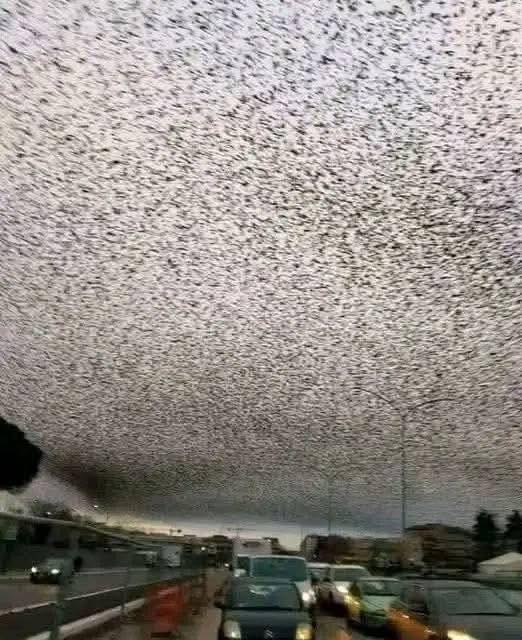Every year, as the chill of winter sets in across Northern Europe, thousands of starlings embark on an incredible journey southward, seeking the milder climates of Italy. Among the most famous destinations for these migratory birds is Rome, where the combination of ancient architecture and urban green spaces provides both food and shelter during the colder months.
As the sun begins its descent over the city’s skyline, something magical happens. The starlings gather in enormous flocks, swirling and twisting in unison, creating complex aerial patterns that have captivated humans for centuries. This spectacular phenomenon, known as a murmuration, turns the Roman sky into a living, shifting tapestry. Tourists, photographers, and scientists flock to vantage points across the city to witness the performance, eager to capture or study the mesmerizing movement.
The Science of Starling Murmurations
A murmuration is more than a pretty spectacle; it is a remarkable display of collective intelligence and coordination. Each bird responds to the movements of its seven nearest neighbors, a phenomenon that allows the flock to twist, dive, and turn as a single entity. These fluid motions can involve thousands, or even tens of thousands, of birds, forming shapes that appear almost choreographed.
Biologists study murmurations to understand principles of swarm behavior, flocking mechanics, and even insights into artificial intelligence and robotics. The patterns are not random; they help protect starlings from predators, confuse hawks and falcons, and allow the birds to communicate and navigate efficiently.
The large-scale coordination exhibited in these displays has drawn parallels to human social systems, traffic flows, and collective decision-making. Observers are often left in awe, struck by the harmony and grace displayed by such small creatures acting as one.
Starlings in Rome: An Annual Phenomenon
Rome has become a renowned hotspot for witnessing winter murmurations. As temperatures drop in Northern Europe, starlings arrive in the city in late November, lingering until early spring. Locations such as the Villa Borghese gardens, Piazza Venezia, and the areas around the Colosseum provide ideal roosting grounds, offering safety from predators and easy access to food sources.
Local authorities and urban ecologists have observed that the starlings are highly adaptable. They thrive in both natural and urban environments, taking advantage of the city’s parks, squares, and rooftops. While this adaptability allows the birds to flourish, it also presents challenges for Rome’s residents and city planners.
The Visual Spectacle
The most captivating aspect of the starlings’ presence is their synchronized flight at dusk. Millions of individuals move together in a fluid dance, appearing as dark, undulating clouds against the fading light. From a distance, the flock can look like an ever-shifting shadow, expanding and contracting, splitting and reforming, often stretching for kilometers across the skyline.
Photographers and nature enthusiasts line the streets, rooftops, and public squares to capture the breathtaking display. Drone footage and high-resolution cameras allow viewers to observe the subtle patterns and spiraling shapes that the human eye might otherwise miss. Many visitors describe the experience as meditative, even spiritual, a reminder of nature’s intricate beauty within an urban environment.
The Benefits of Starling Murmurations
Beyond their aesthetic appeal, the starlings play an ecological role. As foragers, they help control insect populations, consuming significant numbers of pests that might otherwise damage gardens and green spaces. Their presence can contribute to the balance of urban ecosystems, supporting plant pollination and seed dispersal in some cases.
Additionally, the birds’ dramatic displays have boosted tourism. Visitors from around the world plan trips specifically to witness the murmurations, generating economic benefits for local businesses, hotels, and restaurants. For photographers and scientists alike, the phenomenon is a rare opportunity to study complex flocking behavior in an accessible, urban setting.
Challenges for the City
Despite the beauty, the starlings are not without their drawbacks. Residents often contend with the accumulation of bird droppings on streets, vehicles, and public spaces. This can create sanitation issues, necessitating frequent cleaning and maintenance by municipal workers.
Efforts to deter the birds have included bright lights, loud noises, and even temporary netting in certain areas. However, these measures rarely succeed in the long term. The starlings’ migratory instincts and remarkable adaptability mean they return year after year, undeterred by human attempts at deterrence.
In some neighborhoods, residents have voiced frustration over the mess and the noise, particularly during early morning feeding and roosting periods. Municipal authorities face the challenge of balancing conservation and appreciation of wildlife with the needs and comfort of city inhabitants.
Conservation and Ethical Considerations
Starlings, like many urban-adapted species, remind us of the tension between human development and wildlife conservation. While some may view the birds as pests, ecologists caution that they are an essential part of the ecosystem and that non-lethal management strategies are preferable.
Conservationists advocate for approaches that respect the birds’ natural behaviors while minimizing conflicts. For instance, planting native vegetation and creating designated roosting areas can help direct flocks away from high-traffic zones, reducing sanitation concerns while allowing people to enjoy the spectacle.
Murmurations in Culture and History
The fascination with starling murmurations extends far beyond modern photography and social media. Historically, starlings have inspired folklore, poetry, and art. Their dynamic aerial displays have been interpreted as symbols of freedom, unity, and the beauty of collective movement.
In Rome, where history and nature intersect in remarkable ways, these flocks provide an additional layer of cultural significance. Locals and visitors alike draw parallels between the birds’ synchronized flights and the city’s architectural grandeur, seeing in the starlings’ movements a reflection of order, chaos, and harmony coexisting seamlessly.
The Science of Migration
The annual migration of starlings is driven by seasonal changes in temperature and food availability. As winter approaches in Northern Europe, these birds move southward to regions where mild weather ensures sufficient nourishment. Starlings are highly social, migrating in large groups that provide safety and efficiency during the journey.
Research has shown that starlings are capable of remarkable navigational feats, using visual landmarks, magnetic fields, and even patterns of the sun to guide their long-distance travel. Their ability to thrive in diverse environments, from rural fields to densely populated cities like Rome, speaks to their adaptability and resilience.
Tourism and Educational Opportunities
Rome’s winter sky displays have created unique opportunities for education and ecotourism. Schools, universities, and environmental organizations organize field trips and workshops for students to learn about urban ecology, migratory patterns, and the science of flocking behavior.
Tour guides often incorporate starling murmurations into walking tours, providing historical and ecological context. Visitors gain insight not only into the mechanics of the birds’ flight but also into broader themes of biodiversity, conservation, and the human relationship with nature.
Mitigating Human-Wildlife Conflicts
City planners and environmental experts have explored various ways to reduce the friction between residents and the birds. Strategies include:
- Creating designated roosting sites: By providing safe, attractive locations, starlings are encouraged to congregate away from high-traffic urban areas.
- Timed deterrents: Using lights and sounds strategically during early morning or late evening hours can gently guide flocks without harming them.
- Public education campaigns: Informing residents about starlings’ behaviors and ecological benefits can foster tolerance and appreciation.
These measures aim to preserve the spectacular murmurations while minimizing inconvenience to people living in the city.
A Global Phenomenon
While Rome offers a particularly striking example, starling murmurations are a global phenomenon. Similar displays can be observed in the United Kingdom, the Netherlands, and other parts of Europe. Each location offers unique variations, influenced by geography, climate, and urban development.
Studying murmurations in multiple locations allows scientists to compare flocking behaviors, population dynamics, and migratory patterns. The insights gained can inform wildlife management strategies, conservation efforts, and even technological innovations inspired by the birds’ collective intelligence.
Experiencing the Murmurations
For those planning a visit to witness the phenomenon, the best times are typically just before sunset, when the birds gather in large numbers and perform their aerial dance. Ideal vantage points include elevated gardens, hilltops, and open plazas where the sky can be observed without obstruction.
Photographers often recommend high shutter speeds and wide-angle lenses to capture the sweeping movements of the flock. Drones, when permitted, provide an additional perspective, allowing observers to see patterns and formations that are difficult to appreciate from the ground.
The Takeaway
Rome’s winter starling murmurations are a testament to the beauty and complexity of nature, even in urban settings. They offer a rare opportunity to witness coordinated animal behavior on a grand scale, combining science, art, and culture in a single experience.
While the birds’ droppings and noise can pose challenges, their presence enriches the city’s ecosystem, supports biodiversity, and inspires millions of people each year. By balancing appreciation with responsible urban management, Rome demonstrates how humans and wildlife can coexist, even in densely populated environments.
Ultimately, these living clouds of starlings remind us of the wonders that surround us daily. They encourage observation, curiosity, and respect for the intricate patterns of life, proving that even amidst the hustle and bustle of a modern city, nature can still command attention and awe.



